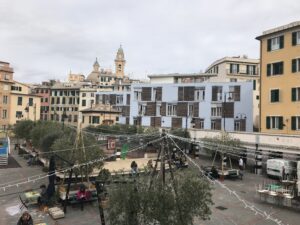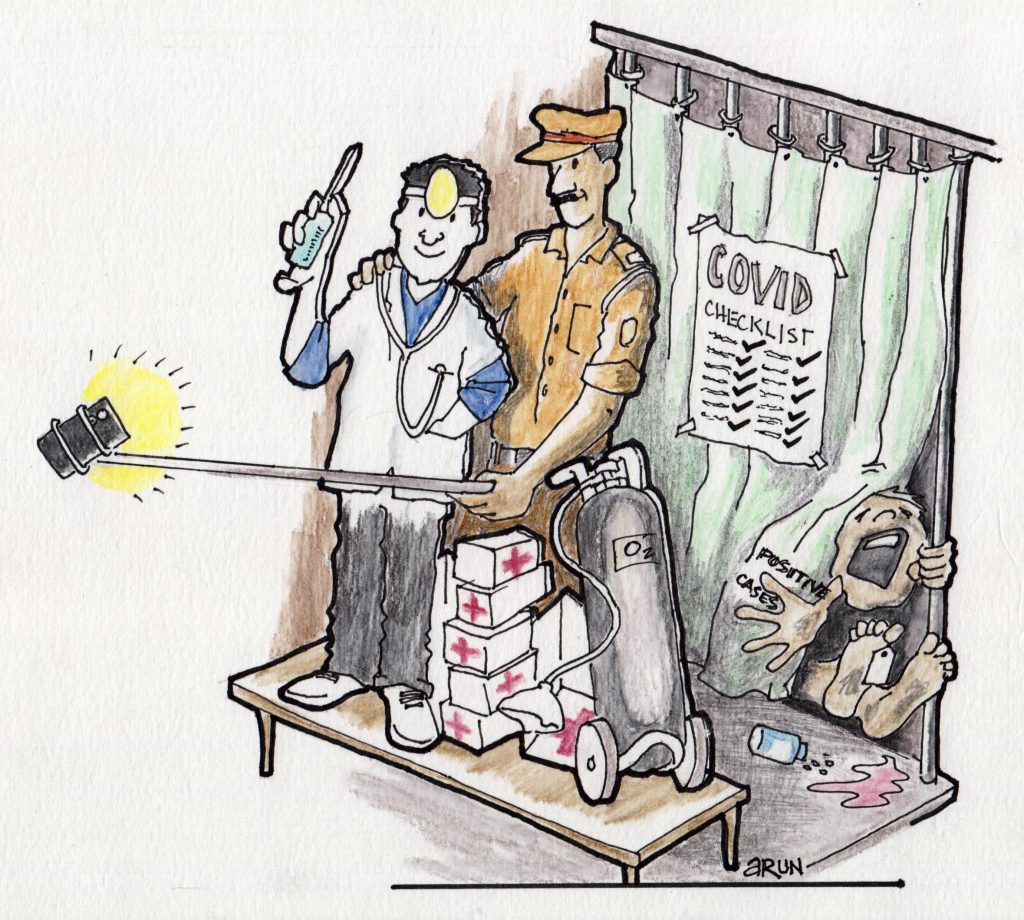
BK-16 Prison Diaries: Arun Ferreira on the farce and tragedy of the pandemic in prison

To mark six years of the arbitrary arrests and imprisonment of political dissidents in the Bhima Koregaon case, The Polis Project is publishing a series of writings by the BK-16, and their families, friends and partners. (Read the introduction to the series here.) By describing various aspects of the past six years, the series offers a glimpse into the BK-16’s lives inside prison, as well as the struggles of their loved ones outside. Each piece in the series is complemented by Arun Ferreira’s striking and evocative artwork.
The first wave of COVID-19 took us all by surprise, universally. We were caught unawares, and our response was clumsy and faltered, often searching for solutions that now appear ridiculous. It was no different in prison, but what made things even worse was the compounded consequences of the farcical implementation of sincere solutions, and the sincere implementation of farcical solutions. Prison authorities did not display any intention of adequately dealing with the pandemic, but were eager to present a façade of an efficient administrative response on official records with a miniscule number of COVID-19 cases.
I, along with my co-accused in the Bhima Koregaon case, were transferred to the Taloja Central Prison on 29 February 2020. This was almost one month before the official declaration of COVID and its associated lockdowns. When we were sent to our respective barracks, we noticed that each barrack had around 35 inmates. A barrack in Taloja Prison had an official capacity of around 25-30 inmates per barrack, so we were only mildly overcrowded as compared to other prisons in and around Mumbai, which faced over 300% overcrowding.
When the virus struck, almost all inmates in the prison were infected. I distinctly remember in April 2020, entire barrack after barrack falling ill with evident signs of the inmates being positive. Yet, no RT-PCR tests were conducted. Instead, whoever presented with symptoms would be taken to the gate of the prison hospital, where an inmate would hand out anti-malarial medicines. The official record in June 2020 claimed that the Taloja Prison had just two COVID positive cases, after conducting 2,217 screenings. What these records omit to mention, however, is that these screenings were of new entrants—not of existing inmates.
The logic, ostensibly, was that the virus would only enter through the main gate and hence if existing inmates were ill, the cause could not be COVID. But the truth has its own way of surfacing: Varavara Rao, my co-accused, was found to be positive when admitted to the City Hospital, in July; eight prison staff were found to be positive in August; and an undertrial who died by suicide in prison was posthumously declared positive in October.
The farcical response of the prison administration was even more apparent in at least four of its official measures and programmes to deal with COVID in prison—the physical distancing norms, the implementation of Supreme Court directions for decongestion in prison, the setting up of temporary prisons and the working of quarantine barracks.
In March 2020, the Supreme Court had in suo motu deliberations directed that all states take measures to ensure the decongestion of prisons during COVID. Among other things, it directed each state government to constitute a High Powered Committee (HPC)—comprising of a sitting high court judge, the principal secretary of the home department and the director general of prisons—to determine which class of prisoners could be released on parole or interim bail. Accordingly, the Maharashtra government constituted an HPC and calculated that in order to make physical distancing possible in its prisons, almost 20,000 prisoners had to be released on parole or interim bail. Convicts serving a sentence of less than seven years were released. But the problem for the state lay in the release of undertrials, despite the apparent presumption of innocence until proven guilty.
When the HPC recommendations became known to prisoners, jubilations broke out in the barracks. Many undertrials even started packing their belongings when they realized that they were within the class of prisoners recommended for release. There was a rush to write interim applications for bail. The few inmates who were educated had to continuously write applications for others. But almost all the interim bail applications of undertrials recommended for release were rejected. The Maharashtra government claimed that its hands were tied as the lower courts were refusing to release prisoners on bail. However, the blame did not lie with the courts hearing such interim bails alone—the public prosecutors who represented the government in those courts had been vehemently opposing the bail of every undertrial the government recommended for release. This deceitful exercise ensured that extremely few got released on interim bail. By November 2020, the Taloja Prison population had almost doubled since our arrival in February.
The most absurd implementation of all was that of physical distancing. By October and November 2020, with the occupancy reaching levels of over 80 inmates within each barrack, the prison officials would institute a practice of “bisthar chadhao”—under which adjoining beddings would overlap each other along their length to reduce space. But when the same inmates were taken outside the barrack, they were made to walk and stand at one-meter intervals of each other. Circles were chalked on the floor for this purpose. The doctor, too, would contrive to follow a two-metre rule. It became clear to all of us that the primary purpose of these chalked circles was to impress visiting officials and supervisory authorities.
The Supreme Court had also recommended setting up temporary prisons as isolation COVID care facilities, following which one set up in a municipal school near Taloja Prison. However, the conditions there turned out to be horrendous. After staying for a minimum period of two weeks at this temporary facility, and undergoing a mandatory screening, the undertrials were brought into to Taloja Prison. Each of them recounted horrible experiences with sleepless nights at the school. The facility had insufficient sleeping space, no adequate water, the few toilets had no doors and human faeces all over the floor, and it was all under the supervision of a drunk jailor who was known for his “batting”—beating the inmates with a lathi.
My co-accused, Gautam Navalakha, suffered the ordeal of the isolation facility not once but twice, and observed that for 350 inmates, there were only three toilets, seven urinals and one bathing facility without either a bucket or mug. The facility was so stressful, that some had to be referred to the psychiatrist upon leaving it and entering the main prison, and another even died by suicide. The jailor and guards on duty also offered premium services at the facility—biryani, special sleeping space and the use of mobile phones could all be arranged—for a price. Some such paying inmates spent more than a lakh for such services during the two-week stint at the temporary prison. In cruel and absurd irony, most inmates were relieved to enter the main prison.
Before they could fully enter the prison, though, inmates in Taloja had to first stay in a “quarantine barracks,” set up within each circle of the prison. The new entrants from the temporary prison would first be lodged in the quarantine barrack for an additional week or two. Unlike other barracks in the prison, the quarantine barrack was continuously locked, with the intention of isolating the new entrants from all other inmates, barring those responsible for food distribution, water supply and cleanliness. What started as a healthy practice in 2020, however, turned into its opposite by 2021-22. These same barracks were now used for inmates returning from the city hospital or court.
What was most ridiculous was the way in which inmates entered and exited. For quarantining, inmates would not come in after the earlier batch left, but would instead be brought in almost daily. After spending their one- or two-week period, they would be taken out. So, in practice, the barrack would have a continuously changing population, and a particular inmate would be in contact with inmates who were brought in earlier and inmates who came later. The quarantine barrack lost its meaning. My co-accused Hany Babu contacted an eye infection and experienced itching and redness at the very end of his two-week period in one such quarantine barrack. This eye infection became extremely serious requiring hospitalisation at a private hospital.
The administration saw no farce in the implementation of these measures. Many officials commented that inmates should be grateful for their care and service during COVID, while thousands were dying outside. Our particular superintendent was even lauded in August 2020 with the President’s award for meritorious service.
Despite all this, there was one silver lining. During the pandemic, Maharashtra introduced phone facilities for inmates across prisoners. There were many prisoners who had not spoken to their family in months, and despite a few problems in its implementation, it was by-and-large extremely beneficial. The facility brought joy to each and every prisoner.





